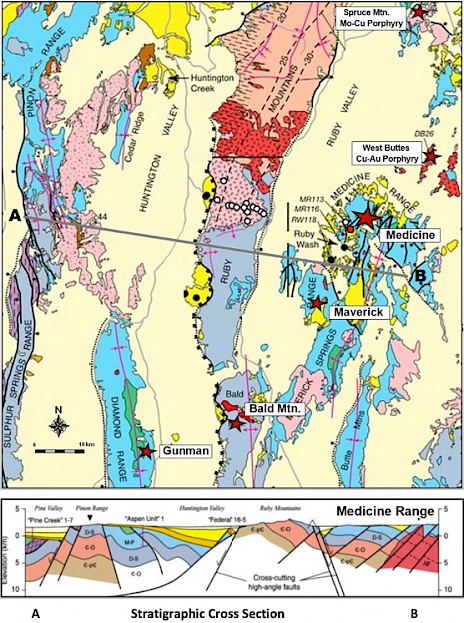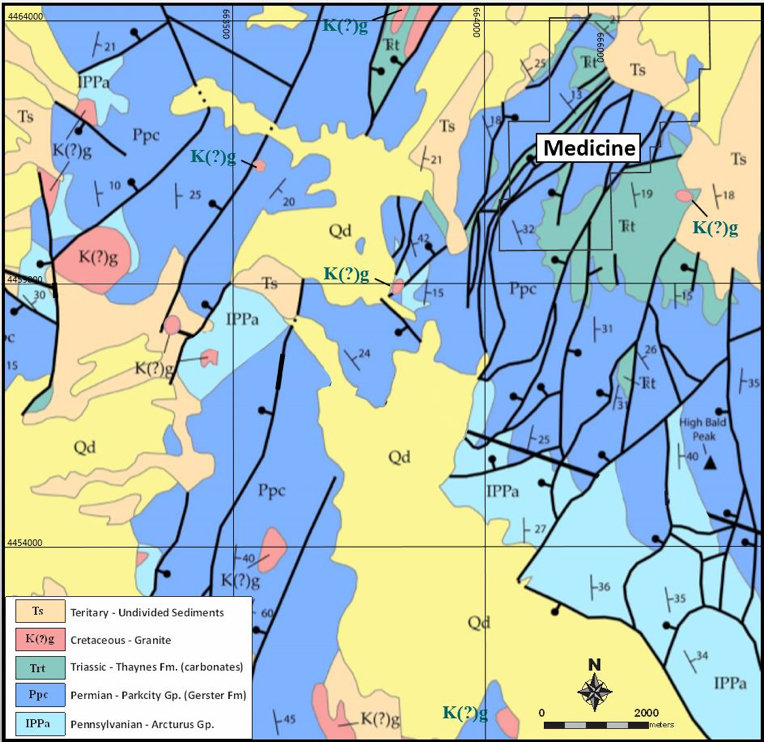Projects
Medicine Springs Project
Geology and Mineralization
Regional Geology
Locally in northeast Nevada, all Paleozoic age rock units were deformed by several stages of compressional folding and faulting. Regional folding occurred in the late Devonian to early Mississippian. Extensional deformation in the Tertiary was responsible for igneous activity accompanied by widespread hydrothermal alteration and a wide variety of mineralized settings. The sedimentary and volcanic stratigraphy extending from the Cambrian through Triassic is locally intruded by Tertiary age stocks and dikes. The Medicine Property is underlain by a complex sequence of Permian-Triassic carbonate and calcareous clastic rock units interrupted by numerous erosional and angular disconformities. The Permian stratigraphy unconformably overlies upper Mississippian clastic rocks which overlies the Cambrian, Ordovician, Devonian and lower Mississippian stratigraphy. These Paleozoic carbonate and clastic rock units hosts a number of significant precious and basemetal deposits localized within a significant northeast trending metallogenic corridor. As illustrated on Figure 4, this corridor is developed over a strike length in excess of 500 kilometers, extending from the Eureka/Ruby Hills silver-gold-basemetals district to the Long Canyon gold deposit in the north. The important characteristics of the deposits in the northeast mineral trend include; spatial relationship with Tertiary intrusives, extensive oxidization, widespread jasperoidal and calc-silicate alteration and dominance of silver-basemetal mineralization.

Project Geology
Mineralization
With reference to Figure 4 and 5, the Medicine Springs silver-zinc-lead-barite oxide mineralization is localized along 2 subparallel north-northeast trending fault systems that encompass the Golden Pipe and Silver Butte prospects. The mineralization is dominated by breccias, jasperoids and zones of decalcification hosted by carbonates of the Gerster Formation. Intensive oxidization has been observed to depth of approximately 150 meters. It is postulated that oxide silver-zinc-lead-barite mineralization overlies sulfide-rich carbonate replacement mineralization which was not tested by the previous shallow drilling programs.
Alteration observed in outcrop and in drill cuttings is dominated by jasperoidal silicification and argillization observed in the calcareous clastic units. A geological analogue for Medicine Springs silver-lead-zinc mineralization hosted by Permian carbonates is documented at the Lone Mountain property located 150 kilometers to the southwest. Carbonate hosted silver-rich basemetal skarns are also observed at Bald Mt, Spruce Mtn and Eureka deposits.

Two styles of oxide mineralization are observed at the Medicine Springs Property, high grade silver-lead-zinc-barite veins and breccias controlled by steep northeast structures and shallow west dipping bedding replacement mineralization hosted by permissive Gerster Formation carbonate units. The mineralization exhibits a close spatial relationship with Tertiary dykes identified from the magnetic data. It is important to emphasize that the older stratigraphic calcareous units underlying the Gerter Fm. offer excellent potential for replacement-style silver-basemetal mineralization when adequate structural preparation exists. Historical exploration defines a silver-lead-zinc mineralized footprint that is traced along northeast trend for 3,400 meters and is up to 1,400 meters in width.
